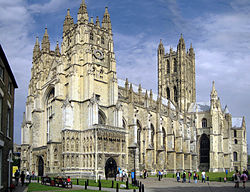| Archbishops of York (Conquest to Reformation) |
|---|
| From | Until | Incumbent | Notes |
|---|
| 1070 | 1100 | Thomas of Bayeux | Also known as Thomas (I). |
| 1100 | 1108 | Gerard | Translated from Hereford. |
| 1109 | 1114 | Thomas (II) | |
| 1119 | 1140 | Thurstan | He was elected in 1114, but was not consecrated until 1119. |
| 1140 | Waltheof of Melrose | Nominated archbishop, but was quashed by King Stephen; later became Abbot of Melrose. |
| 1140 |  Henry de Sully Henry de Sully | Abbot of Fécamp Abbey. Nominated archbishop, but was quashed by Pope Innocent II. |
| 1143 | 1147 | William (FitzHerbert) | Deposed by Pope Eugene III; canonised in 1226. |
| 1147 | Hilary of Chichester | Deposed by Pope Eugene III, elected bishop of Chichester. |
| 1147 | 1153 | Henry Murdac | Formerly Abbot of Fountains Abbey. |
| 1153 | 1154 | William (FitzHerbert) (again) | Restored by Pope Anastasius IV; canonised in 1226. |
| 1154 | 1181 |  Roger de Pont L'Évêque Roger de Pont L'Évêque | Formerly archdeacon of Canterbury. |
| 1191 | 1212 | Geoffrey (Plantagenet) | Formerly bishop-elect of Lincoln; elected archbishop in 1189, but was only consecrated in 1191. |
| 1215 | Simon Langton | Elected archbishop of York in June 1215, but was quashed on 20 August 1215 by Pope Innocent III on request from King John; later became archdeacon of Canterbury. |
| 1216 | 1255 |  Walter de Gray Walter de Gray | Translated from Worcester. |
| 1256 | 1258 | Sewal de Bovil | Formerly Dean of York. |
| 1258 | 1265 | Godfrey Ludham | Also known as Godfrey Kineton. Formerly Dean of York. |
| 1265 | William Langton | Dean of York (1262–1279); elected archbishop in March 1265, but was quashed in November 1265. [12] |
| 1265 | 1266 |  Bonaventure Bonaventure | Selected as archbishop in November 1265, but never consecrated and resigned the appointment in October 1266. |
| 1266 | 1279 | Walter Giffard | Translated from Bath and Wells. |
| 1279 | 1285 | William de Wickwane | |
| 1286 | 1296 | John le Romeyn | Also known as John Romanus. |
| 1298 | 1299 | Henry of Newark | Formerly Dean of York. |
| 1300 | 1304 | Thomas of Corbridge | |
| 1306 | 1315 | William Greenfield | Formerly Dean of Chichester |
| 1317 | 1340 |  William Melton William Melton | |
| 1342 | 1352 | William Zouche | Also known as William de la Zouche. |
| 1353 | 1373 | Cardinal John of Thoresby | Translated from Worcester; created a Cardinal in 1361. [13] |
| 1374 | 1388 | Alexander Neville | Translated to St Andrews in 1388. |
| 1388 | 1396 |  Thomas Arundel Thomas Arundel | Translated from Ely; afterwards translated to Canterbury. |
| 1397 | 1398 | Robert Waldby | Translated from Chichester. |
| 1398 |  Walter Skirlaw Walter Skirlaw | Bishop of Durham, elected but put aside by King Richard II. |
| 1398 | 1405 | Richard le Scrope | Translated from Lichfield. |
| 1405 | 1406 | Thomas Langley | Elected archbishop in August 1405, but was quashed in May 1406. |
| 1406 | 1407 |  Robert Hallam Robert Hallam | Nominated archbishop in May 1406 by Pope Innocent VII, but was vetoed by King Henry IV. |
| 1407 | 1423 | Henry Bowet | Translated from Bath and Wells. |
| 1423 | 1424 | Philip Morgan | Elected archbishop in 1423, but was quashed in 1424. |
| 1424 | 1425 |  Richard Fleming Richard Fleming | Conferred as archbishop by Pope Martin V, but was refused by King Henry V, and Fleming resigned the appointment in July 1425. |
| 1426 | 1452 |  Cardinal John Kemp Cardinal John Kemp | Translated from London; created a Cardinal in 1439; [14] translated to Canterbury. |
| 1452 | 1464 | William Booth | Translated from Lichfield. |
| 1465 | 1476 | George Neville | Translated from Exeter. |
| 1476 | 1480 | Lawrence Booth | Translated from Durham. |
| 1480 | 1500 |  Thomas Rotherham Thomas Rotherham | Translated from Lincoln. |
| 1501 | 1507 |  Thomas Savage Thomas Savage | Translated from London. |
| 1508 | 1514 |  Cardinal Christopher Bainbridge Cardinal Christopher Bainbridge | Translated from Durham; created a Cardinal in 1511. [15] |
| 1514 | 1530 |  Cardinal Thomas Wolsey Cardinal Thomas Wolsey | Translated from Lincoln in 1514; created a Cardinal in 1515; [16] held with Bath and Wells 1518–23, Durham 1523–29 and Winchester 1529–30. |
| Source(s): [11] [17] [18] [19] |





















































